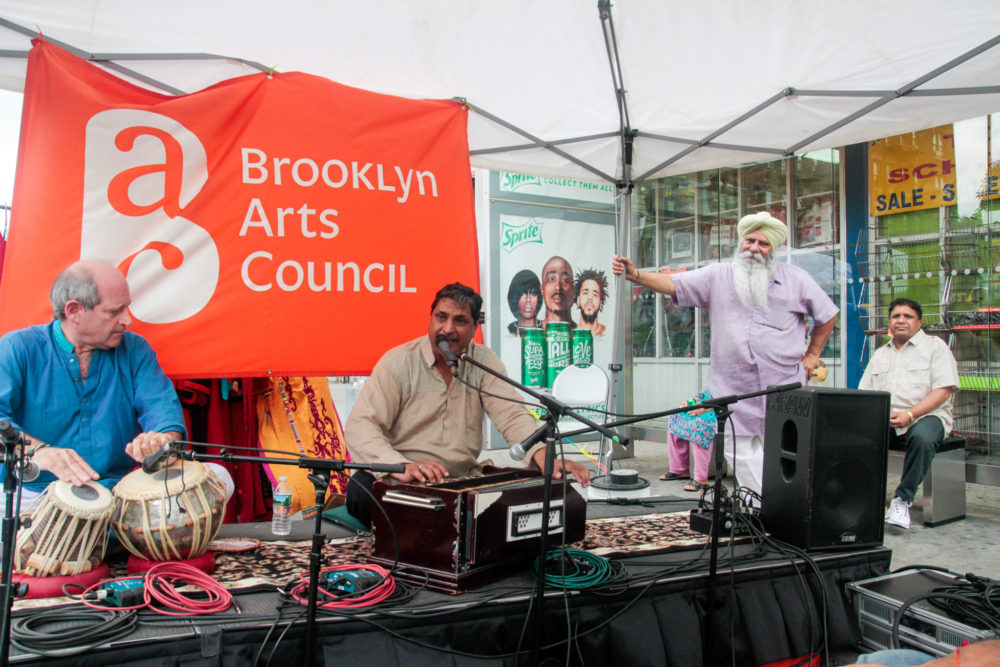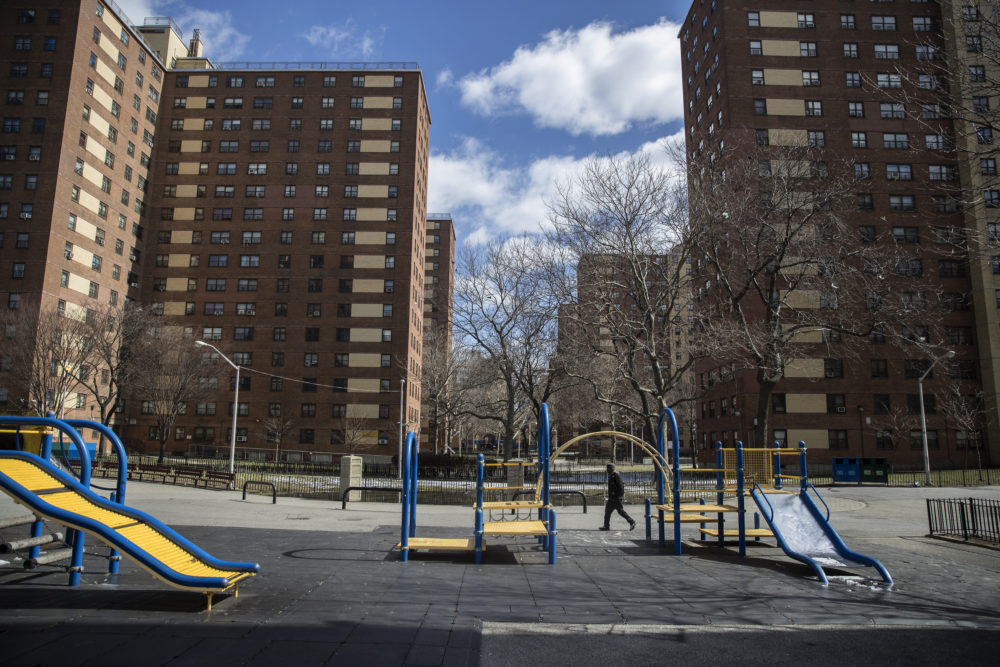For the past 25 years, the Brooklyn Youth Chorus in Cobble Hill has been training 7-18 year olds in the power of expression through song. Along the way, they learn the value of hard work, dedication and accomplishment. Like many arts and social programs in Brooklyn, the chorus depends on grants from the National Endowment for the Arts for a small but pivotal portion of its budget: $30,000 this year. If that money goes away, they organization won’t go belly up, but they simply won’t be able to help as many kids.
President Trump’s proposed discretionary-spending budget for fiscal 2018 would eliminate the NEA’s $148 million budget, along with the budgets for public broadcasting, humanities programs and library services. Those cuts to zero are part of a $54 billion reduction in domestic spending to start paying for a beefed-up Pentagon and a U.S.-Mexico border wall.
Trump’s blueprint, sent to Congress last week, is only the first round in what may be a long battle. Indeed, Republican governors quickly banded together to protest what they view as harmful or arbitrary reductions. In Brooklyn, the cries of alarm went up quickly, since federal spending cuts could have a significant impact on the borough’s thriving cultural scene, its legacy of industrial pollution that has yet to be cleaned up, and its concentrations of poor neighborhoods. “With our most vulnerable neighbors at risk, we must turn our anxiety into action,” said Borough President Eric Adams in a statement. “urge all Brooklynites to organize against this dangerous plan and ensure Washington hears loudly and clearly what we expect from a responsible government, regardless of what political party is in power.”
The Bridge offers these snapshots of Brooklyn programs at risk:
Cuts to the Culture
The NEA sent $47 million last year to arts groups around the country via 24,000 grants. For fiscal year 2017, New York got nearly $8 million of that money through 282 grants. More than four dozen grants went to Brooklyn groups involved in music, dance, theater, writing and other creative arts.
Marie-Laure Kugel, director of development and institutional advancement for the Brooklyn Youth Chorus, said that 40% of her students receive financial aid and that the group has never turned away a student for lack of funding. But she is concerned that limiting programs with such a deep impact on children and artists would send them a dispiriting message. The group’s current program, Silent Voices, which premieres at the Brooklyn Academy of Music on May 12-13, provides a platform for “marginalized communities and those without a voice,” Kugel says. Funding cuts would impair the group’s ability to commission as many local composers and musicians to create such programs. “The negative impact it would have is greater than just the cost to the overall budget,” Kugel said.

The Brooklyn Arts Council, which receives support from the NEA, presents folk-art concerts like this one celebrating Pakistani Independence Day (Photo by Christopher Mulé, Brooklyn Arts Council Folk Arts Director)
Gowanus-based Rooftop Films is the creator of the Summer Series, which screens independent films throughout the city. The group also provides equipment rentals at steep discounts for filmmakers and offers community programs to bring independent film to disadvantaged neighborhoods. The $65,000 the group receives from the NEA makes up only about 3% of its operating budget, but it will threaten Rooftop’s most vulnerable programs and tend to push the independent film community toward creating movies only for people that have the money to pay for them, Rooftop artistic director Daniel Nuxtoll said.
Franklin Furnace, based in Clinton Hill, might be more aptly described as “The Council for Learning English Through Art,” because that’s essentially the mission. Martha Wilson, the founding director, said that 30 years ago, the program originally partnered with PS 130 in Chinatown to help first-generation students learn English. “It was important that they learn quickly. We had five-year-olds having to read leases to their parents.” They found that through visual arts, the students learned vocabulary more quickly.
Over the years, Franklin Furnace has partnered with New York area schools to expand its repertoire, paying resident artists to teach kids filmmaking, theatre games, and the creation of their own art materials. “It serves kids that have different learning styles, so they can excel like traditional learners,” Wilson said. On a budget of about $350,000 annually, the $25,000 the group currently receives NEA won’t shut them down, but it will hurt in a key area. Wilson said that the rigorous documenting process mandated by the NEA requires the group to show that grant money goes directly to paying their teachers. Less money means fewer teachers. “Our civilization will be known for its cultural remains,” Wilson said. “Trump is cutting down the very thing that should stand when he is gone.”
“Brooklyn is epicenter of the arts and culture of New York, maybe the country,” said Charlotte Cohen, executive director of the Brooklyn Arts Council. Cohen said that her organization nurtures artists of all kinds, leaving them strong and more financially viable than when they found them. Cutting NEA funding to groups in Brooklyn would “cut us off from a legacy.” But it isn’t just the direct funding from the NEA that would be diminished. According to Cohen, for every $1 the NEA grants an organization, the group can expect that investment to generate another $7 from other public and private sources. The ripple effect is strong, she said.
Is the Gowanus Clean-up Threatened?
Brooklyn’s most infamous Superfund site, the Gowanus Canal, has been a festering gash in Brooklyn’s side for decades. The 1.8-mile canal, once a thriving transportation corridor, had declined into a toxic, stagnant cesspool, frustrating all efforts to clean it up. The turnaround began in 2009, when the Environmental Protection Agency designated the canal a Superfund site and committed money for dredging and other remedial work. But commercial and residential development leapfrogged the process, so that luxury-apartment rents can exceed $5,000 a month within sniffing distance of the still-putrid canal.

An EPA-sponsored dredging and clean-up of the toxic Gowanus Canal in Brooklyn in October 2016 (Photo by Andrew Lichtenstein)
So the prospect of Trump’s proposed EPA cuts hampering the cleanup is a provocative one. The EPA would be one of the worst-hit federal agencies, losing 31% of its budget, or $2.6 billion. New York Attorney General Eric Schneiderman, holding forth this week at a press conference on the banks of the canal, noted that the Trump budget calls for a 43% reduction in Superfund budgets and a 50% cut in the EPA’s Office of Research and Development, potentially posing an environmental danger to New Yorkers.
Not everyone thinks the Gowanus cleanup is doomed. Natalie Loney, EPA community involvement coordinator, predicted in a regularly scheduled meeting with Gowanus residents that the Superfund money will not be taken away, since it has been legally earmarked to go to cleanup. Moreover, most of cost of the work is being paid by the largest polluters: New York City, whose sewers still dump storm overflows into the canal, and National Grid, which took over responsibility for earlier Gowanus pollution by a company it bought.
Natasia Sidarta, volunteer coordinator for the Gowanus Canal Conservancy, a nonprofit that acts as an environmental steward for the canal and its watershed, said the group’s funding is diverse enough the conservancy could weather the cuts. But efforts to preserve the lands around the canal could be hampered.
The Harm for Housing and Services
Trump’s budget proposal calls for a $6.2 billion decrease in spending for the department of Housing and Urban Development. Among the programs that could be affected would be those that assist with affordable rental housing, home purchasing for low-income families, and legal services.
In Brooklyn, where nearly a third of residents pay more than 50% of their take-home pay for rent, this could cause further hardship. Brooklyn has the most public-housing units (almost 60,000) in New York City; Brownsville has the highest concentration of public housing in the nation.

A playground at the Tilden Houses in the Brownsville neighborhood of Brooklyn (Photo by Victor J. Blue/The New York Times/Redux)
Human-services providers tend to suffer more financial troubles than other non-profits; their insolvency rate in New York City is 18% and may only get worse with the proposed federal budget, said Allison Sesso, executive director of the Human Services Council in New York. “People should expect cuts across the board: job training, health services and the like,” Sesso said.
Marty Needleman, executive director and general counsel for Brooklyn Legal Services Corporation A, believes that cuts to HUD and other social programs could lead to a spike in unemployment as well as tenants being forced out of their homes with no legal recourse. The legal-services group is often the last hope for many Brooklyn tenants who face an uphill legal battle against bad-acting landlords and substandard housing conditions. Needleman said that staff cuts to his organization would put vulnerable people in an even worse spot.
Banding Together
Even though Trump’s budget proposal may reduce overall federal aid, Sesso points out that the city still has significant control over where the money is going. “Trump doesn’t make the decision about what happens in our communities,” Sesso said. “He just makes it harder.”
As the budget battle heats up, it has inspired like-minded groups to band together to increase their impact on lawmakers who’ll vote the budget into law. Eleven Brooklyn cultural organizations, including the Brooklyn Historical Society, Brooklyn Academy of Music, BRIC and St. Ann’s Warehouse, put out a statement March 16 in defense of federal spending on culture.
They pointed out that the 11 institutions had served 2 million adults and 200,000 students in the past year, funded in part by $340,000 in NEA grants and $1.3 million from the National Endowment for the Humanities. Not a huge amount, they pointed out, but a crucial lever for raising funds from many other sources. “The unique offerings of these diverse institutions are part of what makes Brooklyn vibrate with energy and creativity,” they stated. “We believe that a thriving cultural community is an indispensable component of American life, and an essential characteristic of a healthy democracy.”